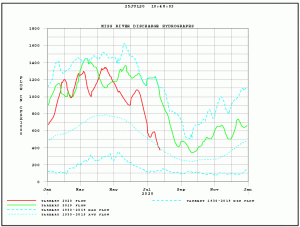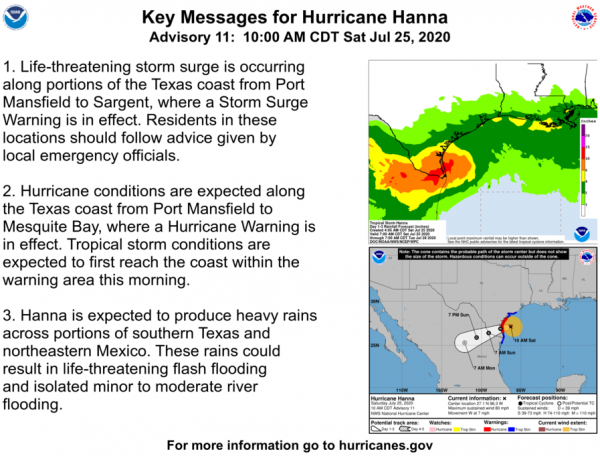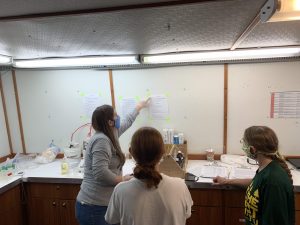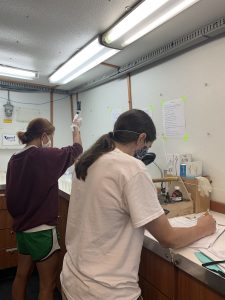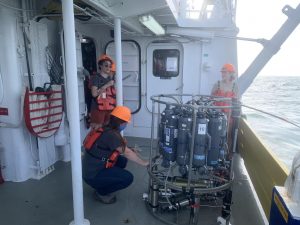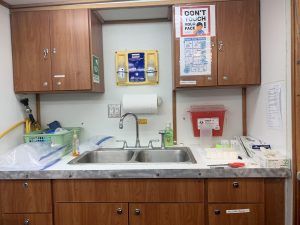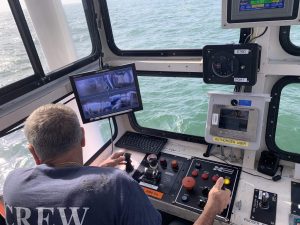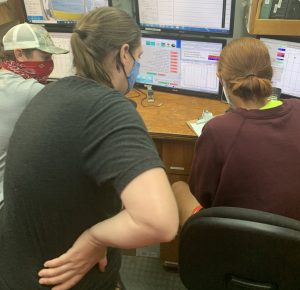[ 2006 | 2007 | 2008 | 2009 | 2010 | 2011 | 2012 | 2013 | 2014 | 2015 | 2016 | 2017 | 2018 | 2019 | 2020 | 2021 | 2022 | 2023 | 2024 | 2025 ]
2020 Shelfwide Cruise: July 25 - August 1
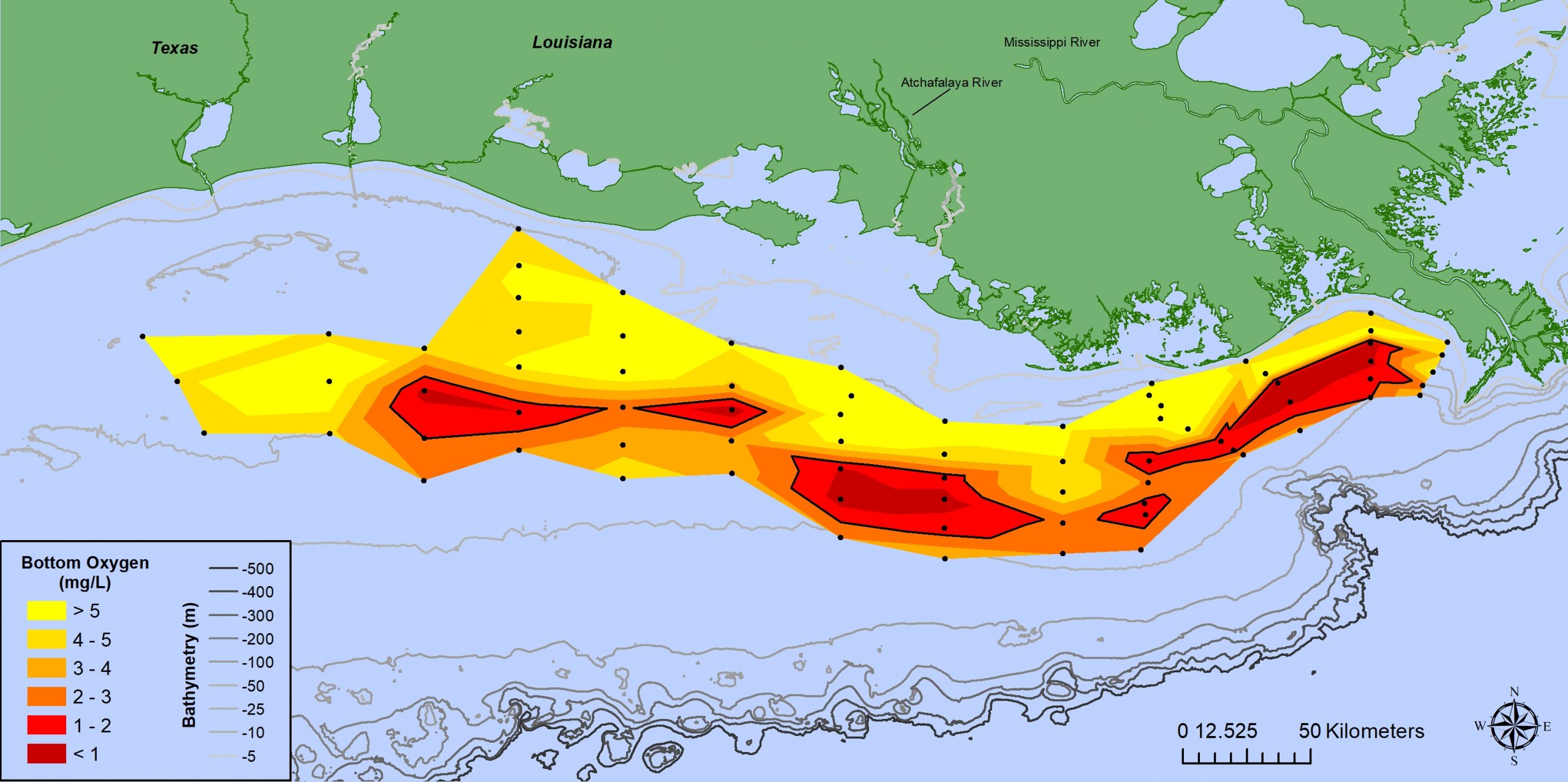
Hypoxia ForecastPress Release
Daily LogMississippi River Discharge
Photo GalleryMarine Forecast
Dissolved Oxygen MapsAdditional Maps
Daily Log
- Blog Format
- Crew Correspondences: This year, daily updates from on board will be coming to you from Tori Lambert. This is Tori’s first hypoxia cruise and first research cruise! She is not new to the sea, however, having lived on a schooner for two months in 2018. The small crew is working around the clock, but as she is able, Tori will be sending out updates of their life at sea. So stay tuned!
Ground Control: Nancy will continue to provide updates throughout the cruise, but will be doing so from land as ground control for the ship out in the Gulf - "This is Ground Control to Major Tori...”
- A Note from Ground Control:
-
Our trepid group of 2020 shelf-wide hypoxia cruise participants have been working hard to get the ship away from the dock. Whose on board and who isn’t:
Dr. Cassandra (Cassie) Glaspie, Louisiana State University, Chief Scientist. Cassie is an assistant professor at LSU and excited about getting involved in the hypoxia project. She was going to come as co-chief scientist to learn the ropes; then Nancy’s injury and she is now Chief Scientist. Cassie published a paper (2019) on shifting diets of fish in the northern Gulf of Mexico hypoxic zone. She has been poring over our Standard Operating Procedures and knows what we do inside and out. Just now needs to put pencil to station log sheet.
Gina Woods, Louisiana Universities Marine Consortium, Co-Chief Scientist. Gina is a research assistant with the Rabalais’ group. She has been doing all the cruise preparations under the watchful eyes of Wendy Morrison and Nancy Rabalais. This includes getting everything together; cruise book; winkler chemicals, f factor, titrator; loading the supplies in the lab, unloading the lab, loading the truck, unloading the truck, loading the Pelican; preparation of the Pelican wet lab space; on Pelican training of volunteers.
Jillian (Jll) Tupitza is a graduate student of Dr. Glaspie. She is interested in benthic ecology and how salinity gradients in Barataria Bay influence the composition of benthic infaunal communities.
Victoria (Torie) Lambert, is a marine educator with LUMCON, and serves as the communications and media person. This cruise is her last activity at LUMCON. She will be departing on August 2 for a masters degree divinity program in Ohio with a concentration in ecology and justice.
Rebecca (Becca) Frowine, is also a marine educator with LUMCON. Her experience prior to this Pelican cruise is small boats and education trips on LUMCON’s RV Acadiana.
Dr. Nancy Rabalais, LSU/LUMCON, principal investigator, is not on board because of a fracture in her cervical 2 vertebra. She has guided this research program since 1985. Her first shelf-wide hypoxia cruise was on the Pelican, its second voyage. Nancy will be on line and participating via Google Hangout in the computer room of the Pelican.
Wendy Morrison, LUMCON, is a senior research associate in the Rabalais’ group, also deputy director of the CWC-III oil spill consortium. She is not on board. She knows everything and has been stepping Gina through all preparations, via phone, photos and emails. She is also the trouble shooter for problems on board.
Dr. Leslie Smith, Your Ocean Consulting LLC, is our data tech, data manager, web site guru, and all other things many of us do not understand. She was on board with us from 2010 through 2015, but on shore for this one. She received her Ph.D. from the University of Rhode Island with studies of Narrangesett Bay and joined many shelf-wide cruises. Her Ph.D. advisor made her come up to me at a science meeting to introduce herself and get to know me. She has been with us ever since.
COVID-19
We all had our two week before and two day before corona virus tests; all were negative. We are considered a ‘low’ risk cruise because we would always be within 24 hours of a port. We have a low capacity science crew to maximize social distancing and to ensure a bunk room would be empty in case someone needed to be quarantined. Daily temperature checks and masks are routine.
Our small science crew (went from 6 to 5, with the loss of Nancy on board) with alternating 3-person 12-h shifts, became all 5 on every shift from 6 am to 10 pm, then all off for rest. Marshall and Adam, marine technicians, are working 2 am to 2 pm and 2 pm to 2 am shifts.
WHAT DID WE EXPECT?
Mississippi River discharge and nitrogen loads were high in May, which would lead to a prediction of a large area of bottom-water hypoxia (estimated at 17,500 to 20,000 square kilometers).
The LSU forecast on size has a caveat about size if there are tropical storms or other wind and wave disturbances. Then the predicted size is estimated to be 70% of the size based on Mississippi River nitrogen load (i.e., 14,000 square kilometers). Well, Tropical Storm Hanna moved from east to west across the central Gulf of Mexico and is slated to cross the Texas shore as Hurricane Hanna on Saturday pm between Port Mansfield and Mesquite Bay.
The passage of the storm across the central Gulf of Mexico contributed to the 5 to 6 foot seas at the beginning of the hypoxia cruise, but will subside into the week. Should conditions remain calm for an extended period, or winds and waves did not mix up the full water column, then more hypoxia may be found to the west of the Mississippi River. This is what we will find out!
- Crew Correspondences:
- Today marks the start of sampling for the Hypoxia 2020 Shelf-wide research cruise! And boy did it start with a bang. With the seas being 4-7 feet with occasional 8 foot waves, the boat was not the only thing rocking and rolling last night. While some feel a little bit better than others, a little sea sickness won’t take this team out!
And... we have found some hypoxia. As we sampled transect A, we had some DO values near 0.4 mg/L. The seas were- thankfully- a lot calmer today. Only 3-4 foot waves for the most part. We had some birds come visit us and found a grasshopper who must’ve jumped on before we cast off. I guess he needed a boat trip too!
- 0600 - Crew Correspondences:

This is "Major" Tori to ground control and the rest of you earth inhabiters... GOOD MORNING! This morning has been MUCH calmer. We all got some much needed rest and it seemed like the seas were nowhere near as intense as the first night. Either that, or we were all so deep in our sleep that we couldn’t tell the difference! It’s really cloudy and there is a chance for rain. But not even rain itself can rain on our parade!! A 0600 start is the perfect way to start our day! Here is a picture of Jill- a PhD student under Dr. Glaspie- on the job!
- 0600 - Crew Correspondences: The Monday Menu!
- Major Tori to Ground Control, we are up and running this morning with some clear blue water and a beautiful blue sky for the first time this trip! With a lot of hard work going on, it’s been really important to stay hydrated and keep our bodies nourished. The theme for the day is inspired by the amazing food that we have had and the need to feed both our bodies and our craving to locate the hypoxic zone.
Here’s what’s on the MONDAY MENU!!! Get ready for some food pun fun!
Breakfast included fruit, yogurt, eggs, bacon, sausage, waffles, bagels, water and- of course- coffee! But NO breakfast is complete without a break to get in the first CTD cast of the day! You can call us butter, because we are ON A ROLL!! Over!
- 1200 - Ground Control:
- I think I have made very station, except for the few times the Pelican internet was out. Tropical Storm Hanna, on its way westward across the central Gulf of Mexico with 5 to 6 foot waves in the area of hypoxia, certainly mixed the upper water column down to about 15 m. This means that stations closer to shore and shallower are less likely to be hypoxic. The hypoxic water mass, what remains of it, has also shifted offshore into deeper waters as a result of the persistent winds from the southeast and south.
We (I’m not even on board) had trouble getting an f-factor from the thiosulfate used to titrate the winklers. That is now solved with a different batch of thiosulfate. Winkler BOD bottles have been taken from the rosette Niskin bottles at a range of dissolved oxygen readings and stockpiled. Soon we hope to see the development of a CTD and YSI6820 comparison to the winkler titrations. This will allow more accurate mapping of the area of low oxygen.
- 1200 - Crew Correspondences: Lunchin with Lawrence!
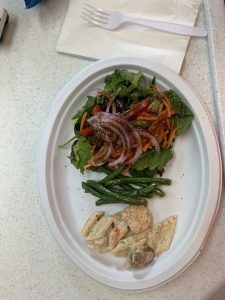
After a morning of sampling, it’s great to be able to sit down to a great meal! Lawrence, the chef on the Pelican, knows this better than anyone. After cooking all up and down the east coast, in the US Navy and various other yachts, he sees his job as a service and loves making people smile with his cooking. As a cook on a research vessel, he loves knowing that he is helping scientists accomplish great things. He even keeps up with meals scientists prefer, so he can be ready with their favorite meals the next time they come on board! As it turns out, weather plays a big role in what he decides to cook. Imagine trying to carry a big pot of soup in those 8 foot waves from the first night...
Here is one meal he has cooked up for us.
Speaking of cooking, we will be serving up some good data on the hypoxia we’ve come across over these past few days. Going along transect D, we have found some more! The sharp change in DO within a single meter is astounding and really eye opening (as a new volunteer on the cruise).
- 1830 - Crew Correspondences: Dinin and Dashin
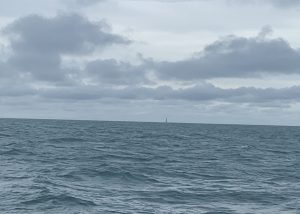
We are dining and dashing (as fast as we can in a 300 ton vessel) to transect E! On the way over, we passed by the light house on the edge of Ship Shoal. The Ship Shoal light first made its appearance in the mid 1800s and was used until the mid 1900s to mark the hazardous area it rests on top of. You can see the structure off in the distance of the picture to the left.
Next on the Monday Menu is to see if we find more hypoxia along Transect E.
- 2200 - Crew Correspondences: Needless to say, we’ve had a full day!
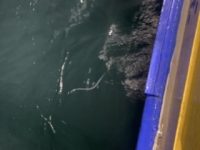
What better way to work off Monday’s dinner than a night time sampling session! We even found a few fishy friends! This needlefish came to check out the CTD! And a few meters below this friend lies... a layer of hypoxia. We sure got our fill of food, fun and fin-tastic sampling for the day. More to come tomorrow!
- Crew Correspondences: “HAIKUS DAY TUESDAY”
- Ground control, this is “Major” Tori coming at you in a Major way!!! Today’s information will be transmitted via Haikus in light of “HAIKUS DAY TUESDAY”!
Full sentences will make an appearance when necessary, but we figured we’d continue challenging ourselves and find our creative sides while we find hypoxia (which we have already found this morning)!
0630 - "Wide awake"
We are awake!
Sampling has now begun!
Lets do this people!0800 - "It’s here!"
Second sample down
And guess what we have just found
Hypoxia y’all!1100 - "Transiting"
Transect E was fun
Now we are headed to F
We are excited!"Titration station"
Winkler titrations
Determining oxygen
Dissolved oxygen"Waiting for the CTD to arrive"
Bubbles arising
From the depths it creeps upward
Emerging with grace"CTD"
Conductivity
With temperature and depth
Measurements arriveAfternoon:
A dry sunny day!
But the sky had other plans.
Now we are all wet.
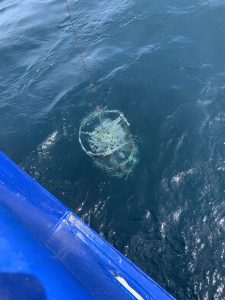
1900:
It’s sunny again!
We are now on transect F
Blue-green seas await!2200:
As Night closes in
Splashes graze us via wind
Another day doneAnother letter
Another transect complete
On to transect G!A subtle jostle
A swaying vessel makes way
The night welcomes itStories of old told
Stories a new have come too
Stories soon to beHypoxia found!
A ways out on transect F
Not too close to shore
- Crew Correspondences: Why Wednesday
- GOOD MORNING GROUND CONTROL!!!
Major Tori to Ground Control, do you read?
0700- We are already off to our second station for the day. Lots of chlorophyll was present at the first station. We’ll see if that changes throughout the day.
Today’s entry revolves around the question I often ask as someone in science: why? Throughout the day we will be asking the science crew and vessels crew various questions starting with “Why...?”
So y'all can start putting names to faces in the blogs, here is a roll call of the team on board.
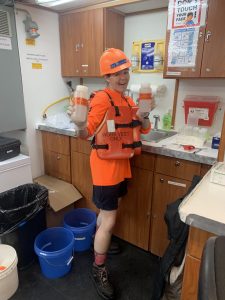 "Major" Tori coming in from the deck.
"Major" Tori coming in from the deck.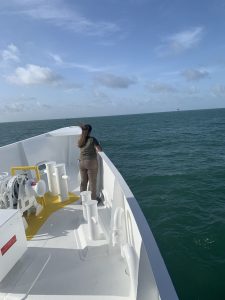 Cassie looking over the bow.
Cassie looking over the bow.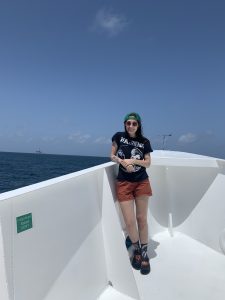 Gina on the bow
Gina on the bow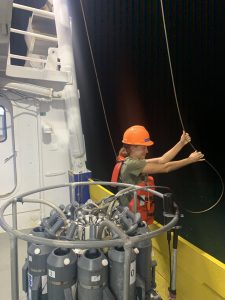 Jill handling the rosette
Jill handling the rosette Becca with the Secchi disk
Becca with the Secchi diskI will start by posing the first question to myself:
Q: Why “Why Wednesday”?
A: I love knowing the reason behind people, places and events! Knowing “why” can help us understand more about a subject or person. I also think it’s important to remember my own “why”- my own reason for why I do what I do. Remembering why were are doing something can give encouragement and drive to keep going!
So, without further ado...
Q: Dr. Cassie Glaspie: Why did you decide to go on this trip?
A: “I have always wanted to do a research cruise. I like to be out on the water. I figured doing what I love (science) while being out on the water would be awesome and I was right. It is a blast!” -CassieDr. Glaspie is a trained oceanographer studying predator prey interactions in near shore biogenic habitats. She was so excited to get the opportunity to go off shore and she is doing an amazing job as the co-lead scientist on board (while Nancy is leading from land).
1200 - In transit to transect H!! We only found hypoxia at one station in transect G. However, it was significant with numbers around 0.2 mg/L for DO.
The next “Why”!
Why did you decide to be a scientist?
I asked Gina this question, who thoughtfully responded: “I guess the easy answer is Steve Irwin!”
Steve Irwin really fostered her love of nature. Always curious, Gina found the idea of being a scientist very cool. Beaker was her favorite muppet and many of the shows she was exposed to as a young girl were geared towards nature, which she has grown to love!Q: WHY is this cruise important to you?
I was going to give Jill some time to think on it, but she knows her why and answered immediately with lots of passion and enthusiasm! “Because I’m a benthic ecologist, I speak for the little critters on the bottom- especially the sessile ones (ones that don’t move). The fish can move out of hypoxic zones, but the things I study can’t...The importance of collecting long term ecological data comes into play when trying to make policy changes that can help them out. Plus, I don’t want those little critters to die... they’re cute... And I’ve always wanted to be a pirate!”WHY did you bring scissors onto this cruise?
“In case I needed to chop off all of my hair. Short hair is way more convenient for field work.” - Becca
We have all come to the consensus that THAT is true commitment from a true scientist- willingness to do whatever it takes for science, including cutting off five years of grown out hair.Major Tori to Ground control... WHY did you decide to study hypoxia?
- Ground Control:
- Our first funding from NOAA was acquired by Don Boesch, then LUMCON Executive Director. He basically handed the projet over to me and said "go forth and study hypoxia." It went from there via competitive research funding. It was (and still is) an important environmental issue and the science linking the Mississippi River watershed and hypoxia in the Gulf of Mexico was intriguing. Our collaborative research group has done great work on the marine science of the northern Gulf of Mexico.
- 0515 - Crew Correspondences: TRANSECT “I-SPY!”
- Ground Control, this is “Major” Tori, signing on a little earlier this morning. We have an update for you. We did not find much hypoxia on Transect H yesterday. We are proceeding with Transect I a half hour earlier today. As we work through Transect I, I am going to challenge all of the earth inhabiters to work through TRANSECT “I-SPY!”
Maybe you’ve been wondering what that chord is in someone’s hand. Maybe you aren’t quite sure what is going on in the lab. I want to shed some light on these super fun things we get to do! Throughout the day I will put up pictures of our progress through Transect I- and beyond. Join us by also seeing if you can pick out what *I Spy* in the photos.
The ítem(s) will be at the top of the photo. The answers with more information will be at the bottom. But NO PEAKING!!! Guess first! Do you copy?
- 0830 - Major” Tori to Ground Control, we have an I Spy coming your way!
- I Spy: 1 rosette, 1 CTD instrument, 5 Niskin Bottles, and 1 technician.
The rosette is the metal frame that contains all of the Niskin bottles and CTD equipment
The CTD instrument is at the bottom of the rosette. With multiple sensors, it measures conductivity, temperature, and depth (plus additional parameters such as Dissolved Oxygen)
Niskin Bottles are the gray sampling bottles placed in a circular pattern inside the rosette. Using computers and live data input from the CTD as it descends, scientists can close these bottles at a specific depth when they see something in the graph that they want to examine further. The samples are taken as the CTD ascends.
The technician: Marshall is our technician for the morning (Adam is our technician for the evening). He maintains the science equipment onboard and is seen rinsing unwanted sediment out of the sensors of the CTD before the first cast this morning.
- 1000 - Major Tori coming through with another Transect I Spy!
- I spy...
A 6820 YSI Display
A Dissolved Oxygen sample bottle
4 hard hats and
A fire hoseBehind Gina and to the left, hanging on the hatch is a small gray 6820 YSI Display. This shows the readings that come from a probe at the end of the chord that Jill is holding. The YSI is another method of sampling that shows water quality data such as temperature, salinity, pH, dissolved oxygen, and many more parameters.
Cassie is holding the DO sample bottle with which she takes a water sample from one of those Niskin bottles in order to further examine the water collected from the desired position in the water column. She must have seen something interesting on the graphs on the computer in the machine tech lab!
The hard hats are the proper PPE we must wear when using equipment on the back deck!
The fire hose is on the left of the picture against the wall.
- 1145 - I spy....
- A DO sample bottle
A volumetric pipette
A Mettler Toledo Winkler Titrator
And
A pair of glovesThe DO sample bottle is making another appearance! After the water sample taken from the Niskin bottle on the rosette, it is brought into the lab and "fixed" with chemical reagents to halt all processes that may be occurring via the microscopic plant and animals called plankton in the water. Adding these chemicals turns the mostly clear water taken from the Niskin into the orange color you see in this picture.
The volumetric pipette is the long skinny glassware with a bulb in the middle that I am holding. We use it to transfer an exact amount sample from the bottle into smaller cups suitable for the titrator.
The Mettler Toledo Winkler Titrator is the machine on the left side of me on the table. Once the sample is transferred into a plastic cup, the cup is secured into the machine and titrated to determine the oxygen concentration in the sample water. This is measurment provides the ground truth for the dissolved oxygen measured by the 6820 YSI and CTD on the rosette. Science always goes back to this titration to affirm the DO that is from a sample of water.
The gloves are on my hands, as they are necessary PPE for using and handling chemicals.
- 1300 - WE SPY HYPOXIA!!!
- Station I6 had a good layer of hypoxia with DO as low as 1 mg/L. So we are headed to I7 to try and find the edge.
- 1730 - WE SPIED DOLPHINS!!!
- As we transited from Transect I to J, there were about 6 or 7 that rode with us for a while!
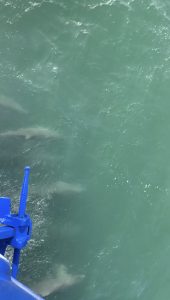
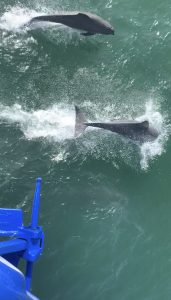
- 1800 - Back at it again! I SPY...
- 3 rolls of tape
8 labeled vials
2 sharpies
1 page of processing proceduresOne roll of tape is the duct tape because- lets be real- you can fix A LOT with duct tape. The other two rolls are white and used for labeling the 8 vials you also spied!
Those 8 vials are filed with water samples from a Niskin bottle and a bucket sample, then transferred into those triple rinsed vials to be placed in the freezer and ultimately processed to measure nutrient concentrations in the water samples.
The sharpies are used to label the vials.
The page of instructions is a helpful start/reminder of procedures. There is NO SHAME in keeping that reminder up even after we have learned the procedures. We want to make sure we are doing everything correctly every time!
- 700 - Crew Correspondences: Friday Favorites!
- Good morning, good morning, good morning!!! It is a BEAUTIFUL FRIDAY on a fabulous boat in the magnificent Gulf of Mexico! As we make our way along transect K and to what lies ahead, we are going to look back at what our “favorites” of this amazing cruise we have had the opportunity to experience.
- 1030 - What’s your favorite place to be on the boat?
- "Major" Tori - My favorite spot is absolutely the bow. I feel like I’m on a rollercoaster, but also just listening to the boat plow through the water is calming at the same time.
“I really don’t know. At the beginning of the cruise, I spent more time on my bunk than anywhere else. If I go up on the bow, I like sitting in the shade by the door at the wheelhouse, because it’s too hot in the sun.” Becca is from Michigan. She is still getting acquainted to the heat.
“I really like the spot near the back of the vessel between the two pillars where I can sit. I love talking with people and being around them, but I also need the time to recharge. That’s where I can be alone and recharge.” -Gina
“I’m gonna have to say the bow! Second up would be between the life rafts. You don’t get the wind you get at the bow, but you get the view.” - Jill
“It’s gotta be the bow! It has the best views of clear blue sky and water. It doesn’t even feel like you’re on a boat. It feels like your flying. Plus it’s where the dolphins like to be, and we all know they have the best taste.” - Cassie
Captain Tad - on the bow by the life jacket box because the wind is usually blocked.
Marshall (technician) - anywhere on the leeward side.
Chef Lawrence- My Bunk

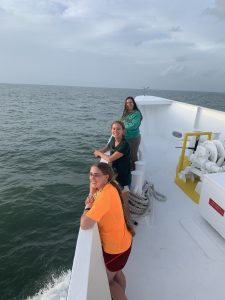
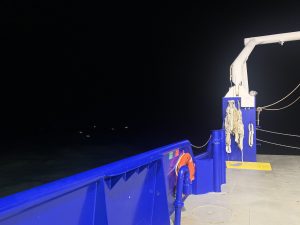
- 1330 - What was your favorite meal you have had on the cruise?
- Becca - That cheesecake! It may have just been because that was the first meal I was able to eat, but it was the cheesecake.
“Major” Tori - The mahi mahi on fried corn patty with roasted vegetables and mango salsa. Mr. Lawrence’s favorite Mediterranean dish to make!
Gina - The Mediterranean dish!
Jill - “The tomato soup we had yesterday... I have no idea what he put in it but it was pure magic.”
Marshall - the spaghetti with belognase noodles
Cassie - the fish (the Mediterranean dish). My favorite part is that the parts of the meal other than the fish stole the show.
*Note: We are pretty sure a major ingredient in all of Lawrence’s dishes is magic.*
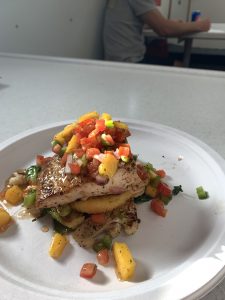
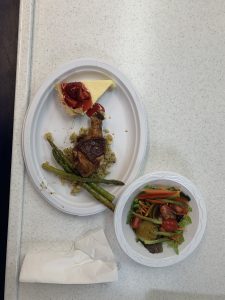
- What is one of your favorite moment on the cruise?
- Cassie - “I liked last night when we saw all of the things on the water. It was really calm. We had just had a comfort food dinner. We started to see squid and stuff in the water. All of the analyses were working. It was a good ‘catch your breath’ moment.”
Becca - “legitimately, it’s ALL been great! Even when I was abominably seasick, I was laying down thinking, ‘I would do this again!’ "
Gina - “There was a moment when we were all outside sampling something and I was like... we're all getting this done! Women in STEM! Yes!! I was just so inspired!”
Jill- “The pod of dolphins that was swimming at the bow was a major check point on my list of things to see.”
“When it started raining so hard and we unflinchingly decided ‘we’re gonna do this’ and we just went for it and got done what we needed to get done.”
"Major" Tori - Finally getting to make the drive down to LUMCON, seeing my fellow marine Educator (Becca), and meeting the rest of the fantastic people that I have been with for the past week!!!
- Heading Home
- At 1530 we made our last cast of the CTD. We all cleaned and organized the wet lab, packed everything and then decided to raid the Ice Cream Freezer. We ate our ice cream outside quickly before it melted, hung out as a crew at the bow, and got to see dolphins, croaker, seabirds, and sharks as we began our transit home. This quickly became one of our favorite memories.
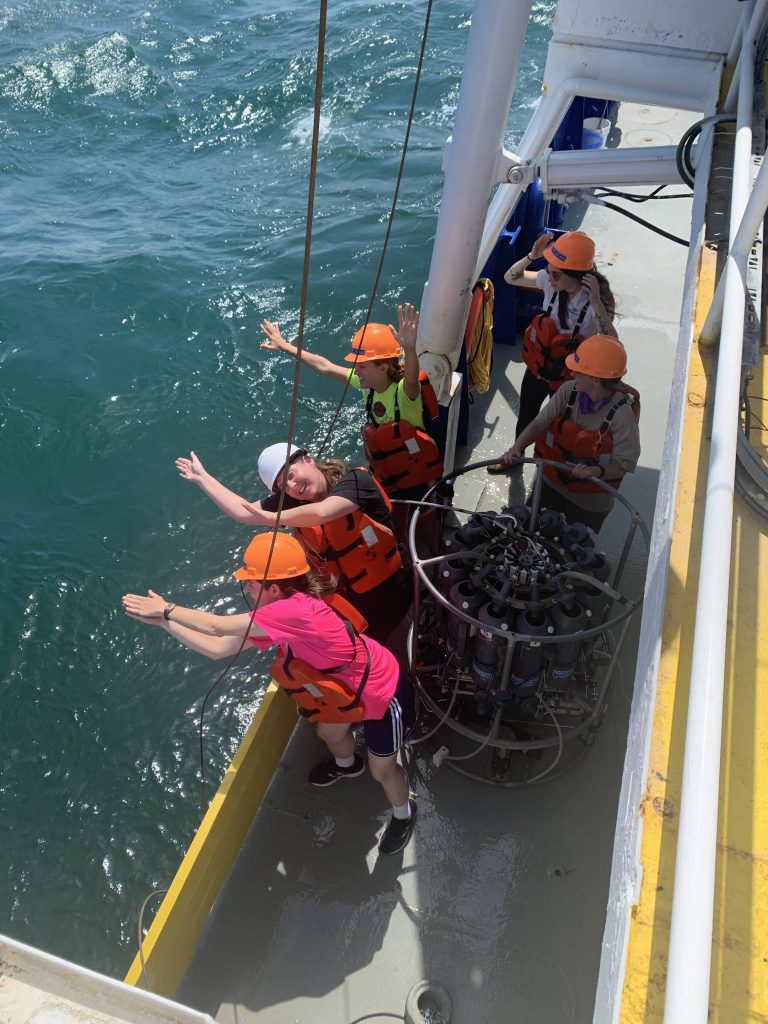
- 1100 - Meet the R/V Pelican Crew
- Ground control, this is Major Tori. This morning's dispatch is a little later than usual as after a week of 16 hour days Major Tori got some much needed sleep! Today marks the final leg of our transit home. We have searched far and wide on this mission to discover hypoxia. We have traversed the Gulf, through wind and rain, sun and smooth seas.
We have found hypoxia in some places, but not in others. We have laughed a lot, worked a lot, and will always remember this mission! However, there are many people you have not seen in the photos that have been with us the whole time. These men make up the R/V Pelican crew, without whom we would not have been able to complete this mission. Today I will show a little bit of what they’ve been doing!
- 1400 - The Pelican has Landed!
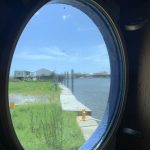
Major Tori to Ground control. The Pelican has landed. We are docked and waiting to unload. This has been an amazing experience. With laughs and long days, casts and conversations, nights and new experiences (and friends) we will hold on to for long after today... mission accomplished.
- 1830 - Farewell from Major Tori
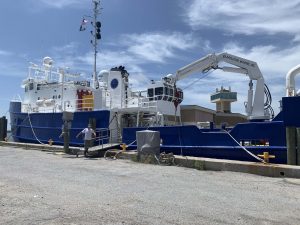
Major Tori to Ground Control. I believe this is my last update. As the mission has come to a close, we have now traveled back to our respective earthbound destinations. We were a little wobbly back on land! “Dock Rock” is definitely a real thing. As we disembarked and unloaded, I must say it was bittersweet. I started this voyage uncertain of my ability to provide the needed assistance, curious as to how it all would go, and hopeful to be of the most help that I could be. I am ending this voyage with new friends, new skills (including my first attempt at blogging, ever) and an experience that will be with me for the rest of my life.I must end with a few notes of gratitude:
To the LUMCON vessels crew, thank you for being the most respectful, most admirable crew that I could’ve imagined. All of your assistance, insight, knowledge, and experience with science has contributed greatly to this cruise and my experience.
To my new friends/colleagues (and fellow marine educator), I am so grateful to have worked alongside women with such great drive, passion, and desire to do everything to the best of your abilities. We came to work. We came to win. We won as a team - cohesive and enthusiastic.
To all those behind the scenes, including Wendy, Leslie, and the rest, your work and dedication to this research and this cruise has not been lost on me. Thank you for all you do!
And, of course, to the Queen of hypoxia herself - Ground Control- Dr. Nancy Rabalais... you have allowed me to have an experience of a lifetime. Your research has greatly benefited science and I am honored to have been able to be a small part of it. Also, thank you for giving me the creative freedom to make this blog as it is. I hope it has brought joy to its readers and a little bit of understanding to what’s happening on this cruise!
This is Major Tori, signing off for the last time.

